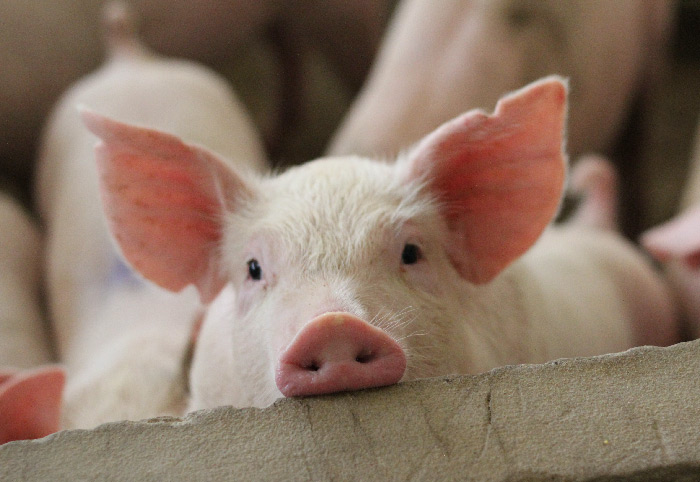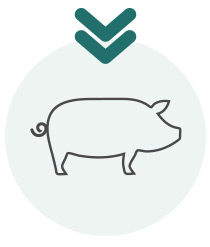
Progressive atrophic rhinitis (PAR)
Disease
Progressive atrophic rhinitis is caused by the bacteria Pasteurella multocida and affects the upper airways and nasal passages of piglets, resulting in sneezing, discharge and distortion or atrophy of the snout.
Damage to the snout can make pigs infected with atrophic rhinitis more vulnerable to other respiratory tract infections like bronchitis and pneumonia.1

Economic impact
PAR can result in reduced growth, meaning infected pigs take longer to reach slaughter.
An estimated 5% decrease in growth during fattening adds approximately $1.39 of production costs per pig slaughtered.2

Cost per pig
$1.39

Weight loss
5%

Prevalence
Effective treatment during the 1970s and 80s mean that PAR is less prevalent than in th e past. However, lapses in vaccination and control programs mean that outbreaks do still occur.
PAR may be eradicated from the herd after a 12-month period of sow vaccination provided all clinical evidence of disease has subsided.3

Diagnosis
The disease has two presentations:
Mild and non-progressive, in which the infection or irritation occurs during a period of 2 to 3 weeks. After that, the swelling stops and nasal turbinates cure, being normal again.
The most severe form of progressive atrophic rhinitis (PAR) in which strains of Pasteurella multocida type D and Bordetella bronchiseptica produce toxins that damage the nasal tissue. When both pathogens are present in the farm, they cause a continuous inflammation in lactating piglets and growing pigs, causing the abovementioned atrophy of tissues and deformities in the nose.
This is based on clinical signs, such as:
- Deviated snouts.
- Sneezing.
- Nasal discharge (swabs for lab. culture).
- Difficulty eating and reduced daily gain.
- Evaluation of nasal turbinates and septum through slaughter checks and on-farm necropsies.
The snouts are graded from 0 to 5, 0 to being a perfect snout. It is only when grades 4 and 5 are present, when there is severe progressive loss of tissue that PAR will be suspected.3

Treatment and prevention
Vaccination of adult animals (sows) against PAR is highly effective.
Farms should also ensure the adequate and early intake of colostrum, which contains high amounts of maternally derived antibodies.
The administration of antibacterial drugs to sows (particularly before farrowing) as well as piglets and newly weaned pigs can also prevent the infection from spreading.2
Improved management (such as improved ventilation, avoiding high stocking levels and using less dusty feed) can also help.
1. Atrophic rhinitis. Diseases manual. www.pig333.com
2. Riising, H.J. et al. Protection of piglets against Atrophic Rhinitis by vaccinating the sow with a vaccine against P. multocida and B. bronchiseptica. The Veterinary Record (2002)
3. Atrphic Rhinitis (AR). Disease Guide. The Pig Site.
Download the disease infographic
MSD Animal Health solutions to control Progressive atrophic rhinitis

SowCare: Porcilis® AR-T DF
Porcilis AR-T DF is an inactivated vaccine for sows that contains B. bronchiseptica
together with a toxoid obtained from a Pasteurella multocida type D toxigenic strain. The immunization of sows protects piglets by means of maternally derived antibodies against atrophic rhinitis.
SOLUTIONS
Porcilis® AR-T DF
Bordetella bronchiseptica bacterin and dermonecrotic toxin toxoid adjuvanted vaccine to control atrophic rhinitis in pigs by vaccinating breeding animals which will then pass on maternally derived antibodies.


BENEFITS
- Reduces the clinical signs of PAR.
- High antibody titers.
HOW TO USE IT
- Primary vaccination: A single IM dose (2 ml) 6 weeks before farrowing, followed, after an interval of 4 weeks, by a second single dose (2 to 4 weeks prior to farrowing).
- Booster vaccination: A single IM dose (2 ml) should be given 2 to 4 weeks prior to each subsequent farrowing.



